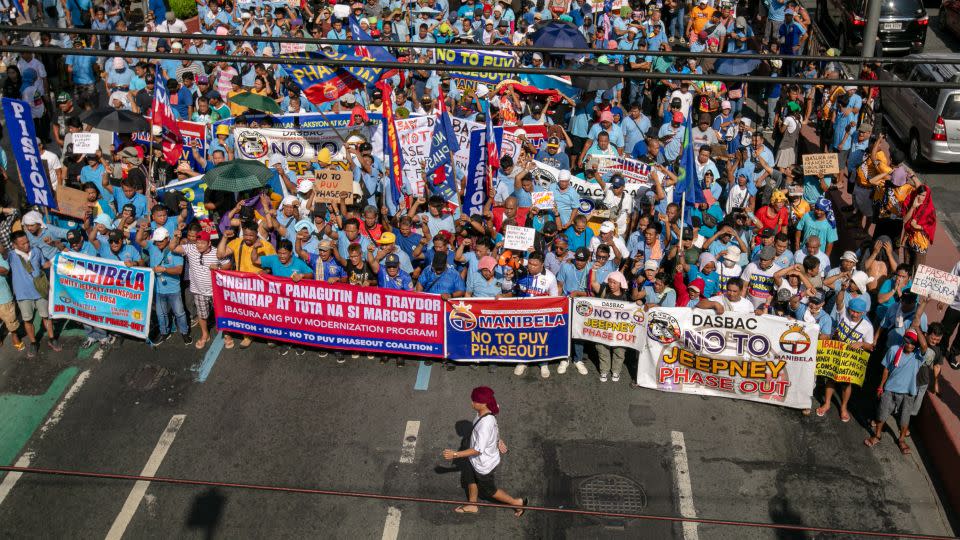Will the colorful, loud jeepneys of the Philippines soon disappear from the roads?
- Oops!Something went wrong.Please try again later.
They rattle through neighborhoods all over the Philippines decked out in gaudy hand-painted liveries featuring everything from the Virgin Mary to NBA stars, shuttling millions of people on their daily commutes to the tune of blaring horns and rumbling engines.
Affectionately called “king of the roads,” this form of public transport emerged from the resourcefulness of the post-World War II era when local mechanics converted huge numbers of jeeps abandoned by American troops, customizing them to accommodate civilian passengers.
With roughly 200,000 jeepneys across the country, they remain an affordable form of transportation in a country where the average annual income is around $3,500.
Jeepney fares start at just 20 cents (13 Philippine pesos), ferrying roughly 40% of commuters everywhere from workplaces, schools and malls, according to data from the Department of Transportation.
But the government wants to replace these often worn-out, highly polluting diesel-powered vehicles with new minibuses.
For years, jeepney drivers have argued that the cost to transition to cleaner vehicles is out of their reach. Meanwhile, commuters also fear that replacing traditional jeepneys with brand new vehicles could eventually lead to fare hikes.
Groups representing jeepney drivers have held protests in recent months, with the latest gathering set for Tuesday in the capital Manila.
But Mar Valbuena, chairman of transport group Manibela, said police attempted to stall jeepney drivers from joining that protest.
“We cannot proceed because some of our members were stuck at police checkpoints this morning… Some have been held at various police checkpoints for nearly two hours,” Valbuena told CNN affiliate CNN Philippines from the start point of the protest.

Valbuena said he still expects roughly 15,000 jeepney drivers, in Manila and other provinces, to protest against a mandatory program to retire the traditional public transport vehicles arguing the scheme was “not studied properly.”
The transport group’s main concern was that the government scheme lacked funds, putting pressure instead on drivers to take hefty loans to comply with the modernization plans.
The uncertain future of jeepneys began in 2017, when the transport ministry ordered vehicles over 15 years old to be replaced with imported minibuses.
The minibuses come with more spacious seating, air-conditioning and runs on cleaner fuel compared with their predecessors – along with a steep price tag of about $50,000 ($2.8 million Philippine pesos), far beyond the reach of many.
“We really can’t afford that… even if we take out a loan, we’d be in debt until we die,” jeepney driver Joseph Sabado told CNN Philippines.
Jeepneys are mostly privately-owned and are often run by a sole proprietor. As a result, individual drivers have been reluctant to upgrade for new buses, saying the transition is pushing them into debt through hefty financing loans.
To qualify for government loans and subsidies, drivers and small-time operators must join cooperatives or corporations, which will own both the buses and the public franchises to operate them.
The government intended to mandate the switch by March 2020 but it has been pushed back three times due to the Covid pandemic.
This time, a firm deadline for jeepney operators to surrender their franchises and consolidate into cooperatives ended on December 31, 2023.
Jeepney owners who failed to join a cooperative will no longer be allowed to drive certain routes starting February, according to Zona Russet Tamayo, a director at the Land Transportation Franchising and Regulatory Board.
The board said it is “determined to implement the program” saying “its benefits far outweigh the misunderstood program flaws,” said chairman Teofilo Guadiz III.

“We will continue to calibrate each component of the program in response to the clamor of the stakeholders, as we have done since the inception of the program. We will remain focused on the program’s primary beneficiaries – the commuters. We believe that overcoming the program’s challenges will lead in dramatic transformation in our transport system,” Guadiz told reporters in a press conference.
Roughly 76% of jeepney owners have chosen to consolidate under the program and over 1,700 cooperatives have been formed, according to official data, but activists dispute those figures and demanded the government to rethink its plan.
“It’s their right to protest, but commuters said they are getting tired of it. The important thing is that the consolidation is done,” Andy Ortega, head of the Office of Transport Cooperatives, told CNN Philippines.
For more CNN news and newsletters create an account at CNN.com

